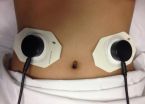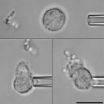(Press-News.org) Treatments involving neck manipulation may be associated with stroke, though it cannot be said with certainty that neck manipulation causes strokes, according to a new scientific statement published in the American Heart Association's journal Stroke.
Cervical artery dissection (CD) is a small tear in the layers of artery walls in the neck. It can result in ischemic stroke if a blood clot forms after a trivial or major trauma in the neck and later causes blockage of a blood vessel in the brain. Cervical artery dissection is an important cause of stroke in young and middle-aged adults.
"Most dissections involve some trauma, stretch or mechanical stress," said José Biller, M.D., lead statement author and professor and chair of neurology at the Loyola University Chicago Stritch School of Medicine. "Sudden movements that can hyperextend or rotate the neck — such as whiplash, certain sports movements, or even violent coughing or vomiting — can result in CD, even if they are deemed inconsequential by the patient."
Although techniques for cervical manipulative therapy vary, some maneuvers used as therapy by health practitioners also extend and rotate the neck and sometimes involve a forceful thrust.
There are four arteries that supply blood to the brain: the two carotid arteries on each side of the neck, and the two vertebral arteries on the back of the neck. The influence of neck manipulation seems more important in vertebral artery dissection than in internal carotid artery dissection.
"Although a cause-and-effect relationship between these therapies and CD has not been established and the risk is probably low, CD can result in serious neurological injury," Biller said. "Patients should be informed of this association before undergoing neck manipulation."
The association between cervical artery dissection and cervical manipulative therapies was identified in case control studies, which aren't designed to prove cause and effect. An association means that there appears to be a relationship between two things, i.e., manipulative therapy of the neck and a greater incidence of cervical dissection/stroke. However, it's not clear whether other factors could account for the apparent relationship.
The relationship between neck manipulation and cervical artery dissection is difficult to evaluate because patients who already are beginning to have a cervical artery dissection may seek treatment to relieve neck pain, a common symptom of cervical artery dissection that can precede symptoms of stroke by several days.
You should seek emergency medical evaluation if you develop neurological symptoms after neck manipulation or trauma, such as:
Pain in the back of your neck or in your head;
Dizziness/vertigo;
Double vision;
Unsteadiness when walking;
Slurred speech;
Nausea and vomiting;
Jerky eye movements.
"Tell the physician if you have recently had a neck trauma or neck manipulation," Biller said. "Some symptoms, such as dizziness or vertigo, are very common and can be due to minor conditions rather than stroke, but giving the information about recent neck manipulation can raise a red flag that you may have a CD rather than a less serious problem, particularly in the presence of neck pain."
INFORMATION:Co-authors are Ralph L. Sacco, M.S., M.D., co-chair; Felipe C. Albuquerque, M.D.; Bart M. Demaerschalk, M.D., M.Sc.; Pierre Fayad, M.D.; Preston H. Long, D.C., Ph.D.; Lori D. Noorollah, M.D.; Peter D. Panagos, M.D.; Wouter I. Schievink, M.D.; Neil E. Schwartz, M.D. Ph.D.; Ashfaq Shuaib, M.D.; David E. Thaler, M.D., Ph.D.; and David L. Tirschwell, M.D., M.Sc., on behalf of the American Heart Association Stroke Council.
The scientific statement is endorsed by the American Association of Neurological Surgeons and the Congress of Neurological Surgeons.
Additional Resources:
Illustrations related to cervical dissection are available on the right column of the release link.
Frequently Asked Questions: Cervical Artery Dissection and Cervical Dissection are available on the right column of the release link.
Follow AHA/ASA news on Twitter @HeartNews.
For stroke science, follow the Stroke journal at @StrokeAHA_ASA
Neck manipulation may be associated with stroke
American Heart Association/American Stroke Association Scientific Statement
2014-08-07
ELSE PRESS RELEASES FROM THIS DATE:
New treatment successful for the Mal de Debarquement Syndrome
2014-08-07
People who suffer from a rare illness, the Mal de Debarquement Syndrome (MdDS), now have a chance for full recovery thanks to treatment developed by researchers at the Icahn School of Medicine at Mount Sinai. Their findings were published online in the July issue of Frontiers in Neurology.
People often feel a sensation of movement, called Mal de Debarquement, after they have finished boating, surfing or a sea voyage. The symptoms usually disappear within hours, but in some people, and more frequently in women, symptoms can continue for months or years, causing fatigue, ...
Northwest Territories on fire and smoke drifts over Labrador Sea
2014-08-07
The fires on the shores of the Great Slave Lake in the Northwest Territories in Canada do not seem in any hurry to be extinguished. In this natural-color satellite image which was collected by the Moderate Resolution Imaging Spectroradiometer (MODIS) aboard the Aqua satellite on July 29, 2014 dozens of fires and copious amounts of smoke are evident. Actively burning areas, detected by MODIS's thermal bands, are outlined in red.
Click on the image above and an image of smoke drifting over the Labrador Sea appears. This smoke has risen off the fires in the Northwest Territories ...
Laparoscopic surgical removal of the gallbladder in pediatric patients is safe
2014-08-07
ROCHESTER, Minn. — A recent study conducted by Mayo Clinic researchers recommends laparoscopic cholecystectomies (surgical removal of the gallbladder) for pediatric patients suffering from gallstones and other gallbladder diseases. This study was published in Surgical Laparoscopy Endoscopy & Percutaneous Techniques.
MULTIMEDIA ALERT: Video and audio are available for download on the Mayo Clinic News Network.
A cholecystectomy is a surgical procedure performed to remove the gallbladder, a pear-shaped organ located below the liver on the upper right side of the abdomen. ...
New disposable biosensor may help physicians determine which patients can safely be fed following surgery
2014-08-07
A disposal, plastic listening device that attaches to the abdomen may help doctors definitively determine which post-operative patients should be fed and which should not, an invention that may improve outcomes, decrease healthcare costs and shorten hospital stays, according to a UCLA study.
Some patients who undergo surgery develop a condition called post-operative ileus (POI), a malfunction of the intestines. The condition causes patients to become ill if they eat too soon, which can lengthen an affected patient's hospital stay by two to three days. Until now, there ...
Team determines structure of a molecular machine that targets viral DNA for destruction
2014-08-07
BOZEMAN, Mont. – With a featured publication in the Aug. 7 issue of Science, Montana State University researchers have made a significant contribution to the understanding of a new field of DNA research, with the acronym CRISPR, that holds enormous promise for fighting infectious diseases and genetic disorders.
The MSU-led research provides the first detailed blueprint of a multi-subunit "molecular machinery" that bacteria use to detect and destroy invading viruses.
"We generally think of bacteria as making us sick, but rarely do we consider what happens when the ...
Expert insights on in vitro alternatives for drug and chemical toxicity testing
2014-08-07
New Rochelle, NY, August 7, 2014—In vitro toxicity testing is rapidly being adopted in the pharmaceutical, chemical, and cosmetics industries, for example, as an alternative to animal studies to predict adverse health effects of drugs and personal care products and the health consequences of environmental exposures. An insightful Roundtable Discussion focused on how to apply these novel toxicology models to everyday hazard prediction, risk assessment, and decision making in industry is published in the preview issue of the new journal Applied In Vitro Toxicology, a peer-reviewed ...
The typhoid fever pathogen uses a cloaking mechanism to evade neutrophil neutralization
2014-08-07
Typhoid fever is caused by systemic (body-wide) infection with Salmonella enterica Typhi. In contrast, infection with the closely related bacterium Salmonella enterica Thyphimurium is usually limited to the gut and causes less serious diarrheal disease. Research published on August 7th in PLOS Pathogens comparing the two pathogens reveals how S. Typhi avoids recognition and elimination by patrolling immune cells called neutrophils, allowing it to disseminate throughout the patient's body.
Neutrophils track down microbial invaders and gobble them up. To investigate why ...
Stanford researchers use fruit flies to unlock mysteries of human diabetes
2014-08-07
For the first time, the tiny fruit fly can be used to study how mutations associated with the development of diabetes affect the production and secretion of the vital hormone insulin.
The advance is due to a new technique devised by researchers at the Stanford University School of Medicine that allows scientists to measure insulin levels in the insects with extremely high sensitivity and reproducibility.
The experimental model is likely to transform the field of diabetes research by bringing the staggering power of fruit fly genetics, honed over 100 years of research, ...
Small, origami-inspired pop-up robots function autonomously
2014-08-07
This release is available in Japanese.
Inspired by the traditional Japanese art form of Origami or "folding paper," researchers have developed a way to coax flat sheets of composite materials to self-fold into complex robots that crawl and turn.
"We demonstrated this process by building a robot that folds itself and walks away without human assistance," said Sam Felton, a Ph.D. candidate at Harvard University's School of Engineering and Applied Sciences and the Wyss Institute for Biologically Inspired Engineering and the lead author of a new report in the 8 August ...
Ocean's most oxygen-deprived zones to shrink under climate change
2014-08-07
As the complex story of climate change unfolds, many of the endings are grim. But there are exceptions. Predictions that the lowest-oxygen environments in the ocean would get worse may not come to pass. Instead, University of Washington research shows climate change, as it weakens the trade winds, could shrink the size of these extreme low-oxygen waters.
"The tropics should actually get better oxygenated as the climate warms up," said Curtis Deutsch, a UW associate professor of oceanography. He is lead author of the study published Aug. 8 in Science.
Warmer water contains ...
LAST 30 PRESS RELEASES:
Making lighter work of calculating fluid and heat flow
Normalizing blood sugar can halve heart attack risk
Lowering blood sugar cuts heart attack risk in people with prediabetes
Study links genetic variants to risk of blinding eye disease in premature infants
Non-opioid ‘pain sponge’ therapy halts cartilage degeneration and relieves chronic pain
AI can pick up cultural values by mimicking how kids learn
China’s ecological redlines offer fast track to 30 x 30 global conservation goal
Invisible indoor threats: emerging household contaminants and their growing risks to human health
Adding antibody treatment to chemo boosts outcomes for children with rare cancer
Germline pathogenic variants among women without a history of breast cancer
Tanning beds triple melanoma risk, potentially causing broad DNA damage
Unique bond identified as key to viral infection speed
Indoor tanning makes youthful skin much older on a genetic level
Mouse model sheds new light on the causes and potential solutions to human GI problems linked to muscular dystrophy
The Journal of Nuclear Medicine ahead-of-print tip sheet: December 12, 2025
Smarter tools for peering into the microscopic world
Applications open for funding to conduct research in the Kinsey Institute archives
Global measure underestimates the severity of food insecurity
Child survivors of critical illness are missing out on timely follow up care
Risk-based vs annual breast cancer screening / the WISDOM randomized clinical trial
University of Toronto launches Electric Vehicle Innovation Ontario to accelerate advanced EV technologies and build Canada’s innovation advantage
Early relapse predicts poor outcomes in aggressive blood cancer
American College of Lifestyle Medicine applauds two CMS models aligned with lifestyle medicine practice and reimbursement
Clinical trial finds cannabis use not a barrier to quitting nicotine vaping
Supplemental nutrition assistance program policies and food insecurity
Switching immune cells to “night mode” could limit damage after a heart attack, study suggests
URI-based Global RIghts Project report spotlights continued troubling trends in worldwide inhumane treatment
Neutrophils are less aggressive at night, explaining why nighttime heart attacks cause less damage than daytime events
Menopausal hormone therapy may not pose breast cancer risk for women with BRCA mutations
Mobile health tool may improve quality of life for adolescent and young adult breast cancer survivors
[Press-News.org] Neck manipulation may be associated with strokeAmerican Heart Association/American Stroke Association Scientific Statement




